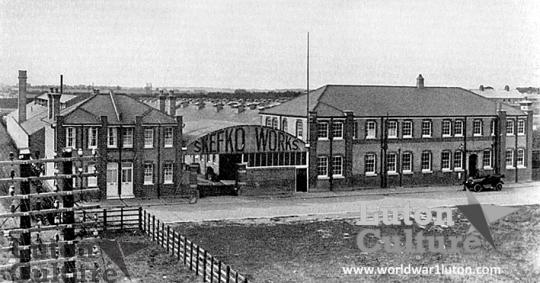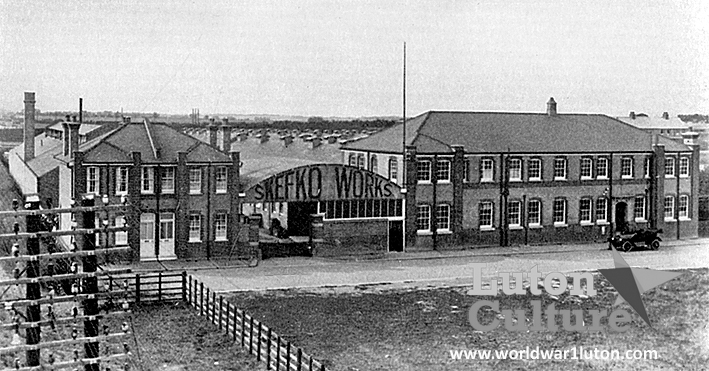Industry in 1919: Skefko
Classification
Source

- The early Skefko works in Leagrave Road in 1911.
For the policy of the Skefko Ball Bearing Co Ltd adaptation is perhaps hardly the correct description, for the Company sum up the position in this way: “Before the war we made ball bearings, during the war we've made ball bearings, and now the war's over we're going on making ball bearings”.
The Company have that advantage over some other firms in the town – their war industry, their pre-war industry and their post-war industry are exactly the same, so no difficult scheme of conversion had to be undertaken before the normal commercial activities of the Company can be resumed.
Like other engineering works in the town, the Skefko buildings have grown enormously during the war and, incidentally, they have been developed on lines which give a somewhat more pleasant exterior to the factory than is sometimes considered necessary in the evolution of industrial premises. Certainly, the news Skefko Works manage, without undue ornamentation, to present to the public view an exterior which is anything but an eyesore, without any sacrifice of internal convenience. But that is quite by the way.
A much more material fact, in so far as the industrial welfare of Luton is concerned, is that these developments were not purely to meet a war-time emergency; a certain amount of extension work had been completed before the war, and much more was contemplated.
The Skefko Company turned out their first bearings at Luton early in 1911, and in 1914 found that although they had made several extensions and were employing between 200 and 250 people, they would have to enter upon a much more extensive development scheme if they were going to make the most of their opportunities.
With the general uncertainty which prevailed for a short time after the declaration of war, the building scheme was postponed for the moment, although the Company showed their enterprise and their certainty of being called upon to play part in the supply of war equipment by buying all the available and suitable raw material they could.
When things had settled themselves somewhat, and it was evident that the Government would provide an urgent, pressing market for all the work the Company could turn out, it was found essential to put the new buildings in hand. They were planned and designed by Sir Alfred Brumwell Thomas, and, as everyone who went along Leagrave Road during their erection will know, they are not makeshift buildings intended to serve just for the war emergency. They have been designed and built on lines which indicate permanence and the Company's confidence in its future in the engineering world.
At the moment night shifts are still being worked, and in out conversations with officials of the Company we gathered that they had every reason for believing they would be able to maintain for the supply of the ordinary commercial market practically their war-time rate of output.
There is one important justification for this view in the extended adoption of ball bearings as an integral feature on machinery. In many types of machine which in pre-war days were not considered to require such bearings, they have since been introduced in the process of manufacture to War Department specification, the manufacturers of such machines have taken kindly to them and will not continue to include them as essential features.
Aeroplane construction, too, has created a considerable and increasing market, and this is perhaps the only direction in which the Company have found their war work require a deviation from their peace-time practice – not a great deviation then, but only one calling for modifications in sizes and proportions.
As to prejudicial competition, no very great fears were entertained for, although the Luton-made article may be more expensive than that produced by German, Swiss or American competitors, the Company's view is that the user benefits in the long run by paying more in the first instance for a superior article and that, although there would always be a market for the cheap production, that was not a matter which worried this Company. As indicating the wide use to which ball bearings are now put, mention was made of the centre pillars of 250-ton cranes, gun mountings and turntables for locomotives.
Naturally, war conditions have necessitated the employment of much female labour. To a small extent this was found useful before the war, but war conditions have called for increasing use to be made of it that at the moment perhaps 25 per cent would be a fairly accurate estimate of its proportion at the Skefko works. To what extent it can be utilised after war conditions have ceased to operate is, of course, a question to which no answer can be given at the moment, but it is possible that, in a much more limited extent, it will still be possible to use it for some classes of work.
Author: Deejaya



Add comment